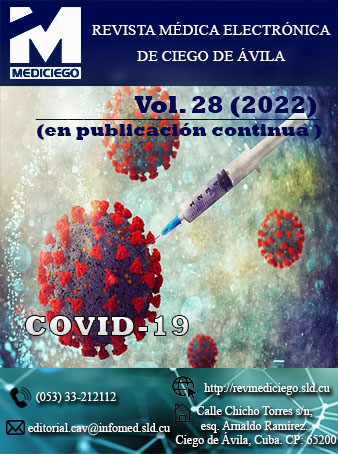Accidental suffocation in a child due to aspiration of a foreign body. Case report
Keywords:
asphyxia, autopsy, forensic medicine, child, fatal outcomeAbstract
Introduction: of the violent deaths, the infantile one is the one with the greatest connotation. Its most frequent medicolegal cause is accidental suffocation. Sometimes, the lack of knowledge of the background of the case, the impossibility –due to the rush– of carrying out the necessary complementary tests, generate doubts in the attending physicians about the causes of death. As there are no external injuries, the forensic finding of the foreign body during the autopsy is the confirmation or revelation of the obstruction of the airways.
Objective: to present a case of death by accidental suffocation of an 11-month-old boy, caused by the aspiration of a foreign body.
Case presentation: 11-month-old boy who, at home, after being alone for a while without supervision, the mother realized that he was suffering from respiratory distress. He was transferred to the emergency service of the General Provincial Teaching Hospital “Dr. Antonio Luaces Iraola” of Ciego de Ávila. Although he was treated by a multidisciplinary group, he died. The presence of the legal doctor on duty was requested, and the necropsy found that the entrance to the glottis was obstructed by a small stone, which prevented breathing.
Conclusions: the 11-month-old boy died due to accidental asphyxiation. Obstruction with a stone, as a foreign body in the airways, caused mechanical asphyxiation and death. The narrowness of the respiratory ducts of the infant, its unfavorable family environment and the distance of the hospital influenced the fatal outcomeDownloads
References
Cardero-Ruiz AE, Mojena-Rodríguez G, Porto-Perera Y, Del Río-Sierra L, Calas-Isaac G. Caracterización clinicoterapéutica de niños y adolescentes con cuerpos extraños aerodigestivos. MEDISAN [Internet]. Abr 2018 [citado 2 Feb 2021];22(4):384-93. Disponible en: http://scielo.sld.cu/pdf/san/v22n4/san08224.pdf
Ferreras-Amez JM, Andrés-Bergareche I, Abadía-Gallego V, Sarrat-Torres M, Vicente-Molinero A. Cuerpo extraño bronquial, una patología insospechada. Rev Portales Médicos [Internet]. 2012 [citado 2 Feb 2021]:VII(15):[aprox. 5 p.]. Disponible en: https://www.revista-portalesmedicos.com/revista-medica/cuerpo-extrano-bronquial-una-patologia-insospechada/
Torres-Márquez M, Fonseca-Pelegrín CL, Díaz-Martínez MD, Del Campo-Mulet OA, Roché-Hernández R. Accidentes en la infancia: una problemática actual en pediatría. MEDISAN [Internet]. Abr 2010 [citado 2 Feb 2021];14(3):368-78. Disponible en: http://scielo.sld.cu/pdf/san/v14n3/san13310.pdf
De Leonardis D, Ibáñez S, Rocha S, Misol A, Gerolami A, Sehabiague G. Foreign body aspiration in the Emergency Unit at the pediatrics hospital: Handling of ten cases and update. Arch Pediatr Urug. [Internet]. 2016 [citado 2 Feb 2021];87(2):99-107. Disponible e: http://www.revisionporpares.com/index.php/APM/article/download/6652/1062
Benincore-Robledo A, Gutiérrez-Morales G, Cuevas-Schacht FJ. Aspiración de cuerpo extraño. Acta Pediatr Mex. [Internet]. May 2019 [citado 2 Feb 2021];40(3):170-9. Disponible e: https://ojs.actapediatrica.org.mx/index.php/APM/article/download/1814/1138
Chen X, Zhang C. Foreign body aspiration in children: focus on the impact of delayed treatment. Int J Pediatr Otorhinolaryngol. May 2017;96:111-5.
Sheehan CC, López J, Elmaraghy CA. Low rate of positive bronchoscopy for suspected foreign body aspiration in infants. Int J Pediatr Otorhinolaryngol [Internet]. Ene 2018 [citado 2 Feb 2021];104:72-5. Disponible en: https://www.researchgate.net/profile/Joseph-Lopez-4/publication/321722566_Low_rate_of_positive_bronchoscopy_for_suspected_foreign_body_aspiration_in_infants/links/5a2e33ec45851552ae7f137b/Low-rate-of-positive-bronchoscopy-for-suspected-foreign-body-aspiration-in-infants.pdf
Published
How to Cite
Issue
Section
License
Copyright (c) 2022 Valia Pérez Pérez

This work is licensed under a Creative Commons Attribution-NonCommercial 4.0 International License.
Those authors who have publications with this journal accept the following terms of the License CC Attribution-NonCommercial 4.0 International (CC BY-NC 4.0):
You are free to:
- Share — copy and redistribute the material in any medium or format for any purpose, even commercially.
- Adapt — remix, transform, and build upon the material for any purpose, even commercially.
The licensor cannot revoke these freedoms as long as you follow the license terms.
Under the following terms:
- Attribution — You must give appropriate credit , provide a link to the license, and indicate if changes were made . You may do so in any reasonable manner, but not in any way that suggests the licensor endorses you or your use
- No additional restrictions — You may not apply legal terms or technological measures that legally restrict others from doing anything the license permits.
The journal is not responsible for the opinions and concepts expressed in the works, which are the exclusive responsibility of the authors. The Editor, with the assistance of the Editorial Committee, reserves the right to suggest or request advisable or necessary modifications. Original scientific works are accepted for publication, as are the results of research of interest that have not been published or sent to another journal for the same purpose.
The mention of trademarks of specific equipment, instruments or materials is for identification purposes, and there is no promotional commitment in relation to them, neither by the authors nor by the editor.






















